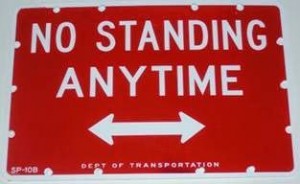You can’t sue somebody for doing something that did not actually hurt you. However outrageous someone’s behavior might be, unless it directly hurts you in some way, courts will say it is none of your business.
That is one of the oldest principles of law, referred to by lawyers and judges as “standing.” You do not have “standing” to file a lawsuit unless you can prove you were harmed.
 Last week the U.S. Supreme Court listened to arguments in one of the most interesting and possibly important cases on “standing” in recent memory. It involves the U.S. Army Corps of Engineers, though it is an issue that could also affect activities at the Environmental Protection Agency, the Bureau of Land Management, Forest Service, Park Service, and others.
Last week the U.S. Supreme Court listened to arguments in one of the most interesting and possibly important cases on “standing” in recent memory. It involves the U.S. Army Corps of Engineers, though it is an issue that could also affect activities at the Environmental Protection Agency, the Bureau of Land Management, Forest Service, Park Service, and others.
Under the 40-year-old Clean Water Act, the Corps of Engineers has to issue permits for activities that could impact waterways over which the Corps has “jurisdiction.” So there is a 40-year-old debate on which waters that includes. The purpose of the law was to stop pollution of the nation’s rivers, over which the federal government would have legitimate authority if they cross state lines and are used in interstate commerce. So the law referred to such rivers as “navigable waterways,” though over the years virtually all rivers and streams in the country have been determined to fit that definition — whether they are commercially navigable or not. But that determination remains hotly controversial, regularly debated in Congress, and subject to legislation and lawsuits all the time.
There is a fairly simple legal question that has always been unanswered. If the Corps declares some waterway under its jurisdiction, then anyone proposing a project that might impact that waterway (a bridge or levy, for instance) would need a permit. But what if there is disagreement over whether the Corps has jurisdiction over that waterway? What if the waterway is not navigable, does not cross state lines, and has no connection to interstate commerce?
The requirement to get a federal permit is onerous. It can add millions of dollars and years of additional work to projects that would otherwise be far less expensive. So in two separate cases, project owners sued the Corps over that “jurisdiction” decision, claiming it would cost the owners significantly more for permits that should not be required.
The legal argument is that age-old “standing” issue. Does anyone have “standing” to sue over a decision that a project will need a permit? Again, that depends on whether anyone can show they were harmed by that decision, which is debatable. In a Louisiana case, the courts ruled that the Corps’ decision wouldn’t harm anyone until it resulted in some enforcement action. Unless the project owner had been punished for doing something illegal, there was no “harm” done by simply deciding a permit would be required. The permit affects the future, not the past or present, said the courts. The Corps’ decision was not considered to be a final decision, since the permit had not yet been either issued or denied. Thus, the lawsuit was filed too early, before anyone had been harmed.
That is an interesting legal theory that can be used by the government in many situations. Until a federal agency makes a “final decision” on something (whether to issue a permit, or whether to fine someone who violates the requirements), regulators can always claim nobody is yet harmed — even though it is well known that the permitting process itself is certain to delay a project and drive up its cost. In the Louisiana case, the courts did not consider that to be harmful.
But in an almost identical Minnesota case, the lower courts made a completely opposite ruling, finding that the Corps’ decision resulted in additional costs, and therefore the project owner was harmed financially. Therefore, that court said the agency decision to require a permit was in fact a “final decision,” against which a lawsuit could be filed.
With two federal appellate courts on opposite sides of the same issue, everyone who has ever had to wrestle with this issue now awaits a ruling from the Supreme Court. That includes the Corps, the EPA, and hundreds of local and state governments across the country, along with contractors and developers of every conceivable kind.
It is not often that such lengthy and expensive litigation swirls for so many years over a question as simple as “is it a decision or isn’t it?” To those who must bear the costs of federal permitting, it sure seems like it.
A version of this column originally appeared in the Grand Junction Daily Sentinel April 8, 2016




Comments on this entry are closed.